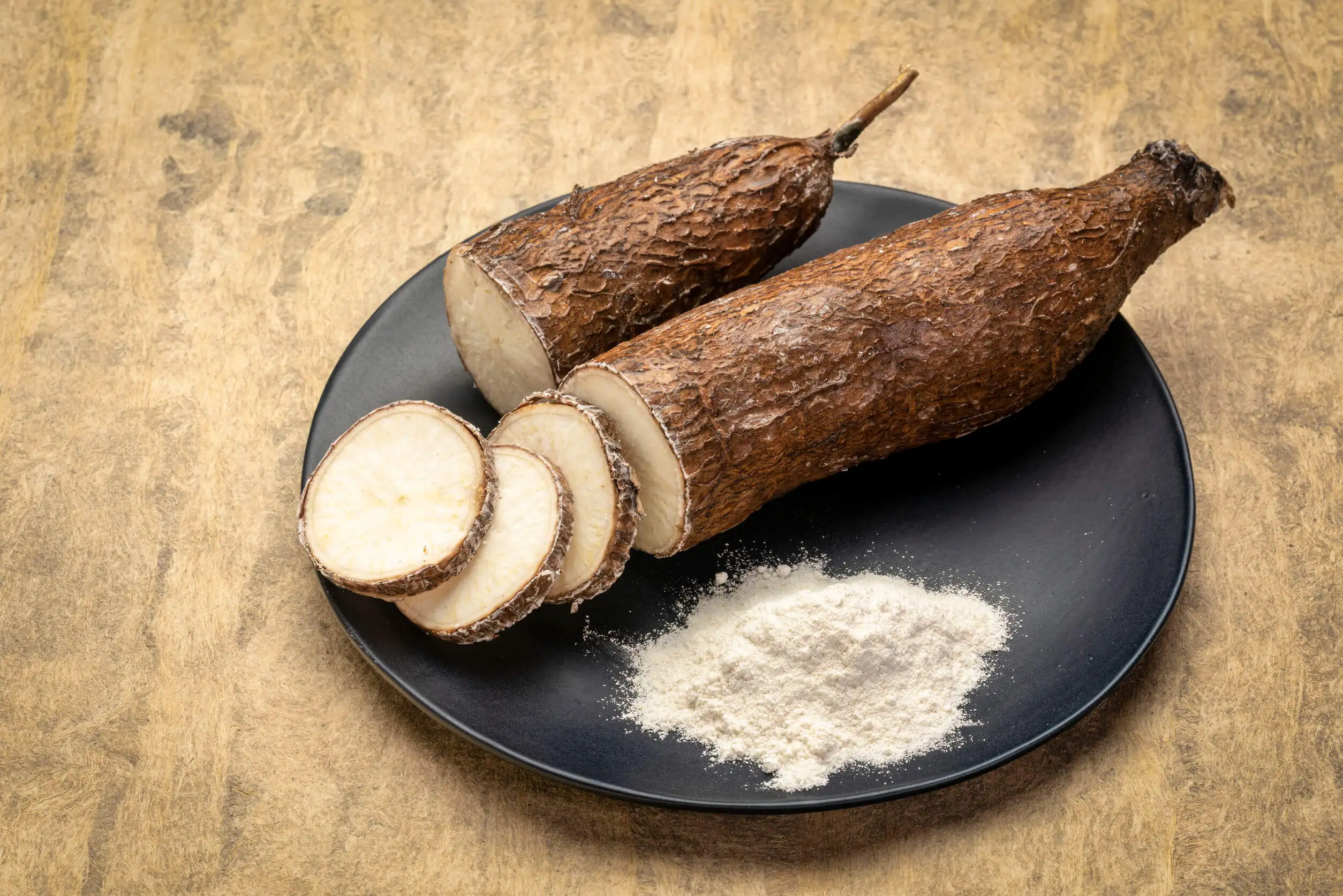Tapioca: What It Is, Benefits and Contraindications


Written and verified by the nutritionist Maria Patricia Pinero Corredor
Tapioca is the starch extracted from cassava, a root that is considered the fourth most important commodity, consumed by more than 1 billion people in the world, according to the Food and Agriculture Organization of the United Nations (FAO).
The name originates from the Guarani language. Tipiog means ‘starch’ or ‘carbohydrate extracted from cassava’. It had its beginnings in Central and South America (Guatemala and Brazil). It’s marketed in the form of pearls or spheres, but also as flour, flakes and starch.
Its neutral flavor allows it to be very versatile in the kitchen. It can be used in both sweet and savory dishes, so it stands out in desserts with milk, puddings, soups, and sauces, and is an excellent thickener of many preparations.
However, despite its frequent use, it can also be controversial, since in addition to its benefits, some say it could have harmful effects. Read on to learn all about tapioca.
Where is tapioca obtained from?
Tapioca is obtained in different ways. The most common process is the one suggested by Alarcón and Dufour, which involves breaking the cell walls of the cassava by grating or grinding to extract the starch with water. It’s then filtered before drying, leaving a fine powder.
Another technique, a little more traditional, involves leaving the starch to stand for a longer time in water and then decanting it. It’s dried in the sun to be processed into powder, pearls, or flakes. It should be noted that these have to be soaked or boiled before consumption. In general, they double in size, swell and become transparent.
Drying in both cases is important, because it eliminates all the toxins that are naturally found in the cassava and remain suspended in the water. For example, the cyanide in cassava can be poisonous according to its final concentration.
Another novel method consists of obtaining starch without using water as a means of extraction, through a grinding stage and two stages of dehydration. Thus, a partially modified starch is obtained.
To avoid confusion, it’s also important to differentiate tapioca flour from cassava flour. The latter is obtained by grating, drying, and milling the whole root. In the case of tapioca flour, it’s only starch extracted from the ground cassava.

Nutritional value
Due to the way tapioca is obtained, its main nutritional component is starch, which represents almost the totality of the product. Data indicate that the pearl presentation contains low values of fiber, protein, fat, vitamins and minerals.
A comparative study shows that tapioca contains less than 1% of protein, fat, and ash and almost 90% of carbohydrates. Its low vitamin and mineral values make it nutritionally inferior to other starch sources, such as cereals and grains.
The calorie intake of this cassava product is empty, as there are no other essential nutrients to accompany it. About 100 grams (4 oz) of tapioca contains 345 calories.
Read also: Are Carbohydrates Important in Your Diet?
Possible benefits of tapioca
Tapioca can be an excellent choice when used in restricted diets. For example, many people with celiac disease, sensitive or intolerant to gluten or grains can substitute the starch in wheat and other cereals that are sources of gluten, as well as in legumes, for the starch in tapioca.
If you use it as a substitute, you can combine it with other flours, such as coconut, almond, walnut, and other nut flours to increase its nutrients.
According to some experts, another benefit of tapioca is the presence of resistant starch as a natural source in cassava, which has the particularity that it isn’t easily digested. Therefore, it behaves like fiber.
Resistant starch can be used as food by beneficial bacteria in the intestine, decreasing inflammation and eliminating harmful bacteria.
A review in Advances in Nutrition highlights that resistant starch decreases gastric emptying, improves glucose and insulin absorption, and increases satiety. That is, it can contribute to better metabolic health.
However, we shouldn’t rule out the use of green bananas, cooked potatoes, legumes and rice as important sources of resistant starch and other nutrients that are absent in tapioca.
Discover more about he different Types of Celiac Disease and Their Characteristics
Contraindications and care
A group of food technologists have recommended certain precautions with the consumption of tapioca, especially when cassava is poorly processed. In this case, it can cause health problems, since it contains a toxic component called linamarin, which turns into cyanide when ingested.
Some studies show cyanide poisoning when bitter cassava is consumed, causing the paralysis known as konzo and even death; this is frequent in African countries.
On the other hand, experts say that people allergic to latex can develop cross-reactivity when consuming cassava. That is to say, the organism confuses some compounds of cassava with latex allergens. It’s also known as the latex-fruit syndrome.

How to prepare tapioca?
Tapioca can be used, according to its presentation, in different ways. Its neutral flavor allows it to be mixed in sweet and savory recipes. It can also be combined with other flours to enrich it.
- Tapioca pearls: These pearls need to be boiled before consumption. The ideal ratio for each part of pearl is 8 parts of water. They’re cooked over a low heat and stirred constantly so that they don’t stick together. Once they float, the heat should be reduced, and you should let them boil for 15 to 30 minutes. Then they rest for the same time.
- Tapioca flour or flakes: Tapioca flour is used as a good thickener for soups, sauces, or broth-based sauces. It can improve the texture of baked dishes and can be used as a binder in hamburgers or meatloaf. Two tablespoons of tapioca are recommended for each tablespoon of corn starch.
- Bubble tea: This is made with tapioca pearls, milk, syrup, and ice cubes. It’s a tradition to make bubble tea with black tapioca pearls that are mixed with brown sugar.
So, in summary, tapioca is a product derived from cassava, whose high starch content and low nutrient value doesn’t prevent it from being used as an eventual substitute for foods that are sources of gluten or legumes. It also has wide applications in the kitchen, as we have seen.
All cited sources were thoroughly reviewed by our team to ensure their quality, reliability, currency, and validity. The bibliography of this article was considered reliable and of academic or scientific accuracy.
- Buzati Pereira B. L, Leonel M. (2014). Resistant Starch in cassava products. Food Science and Technology. 34 (2). https://www.scielo.br/j/cta/a/mPXv8WvxJDJ3yxTDpNWdJcr/?lang=en
- Centers for Disease Control and Prevention. Outbreak of cyanide poisoning caused by consumption of cassava flour – Kasese District, Uganda, September 2017. Publicado en Weekly, Abril 2019. 68 (13): 308-311. Consultado el 24 de enero de 2023. https://www.cdc.gov/mmwr/volumes/68/wr/mm6813a3.htm
- Ibero M, Castillo MJ, Pineda F. (2007). Allergy to cassava: a new allergenic food with cross-reactivity to latex. Journal of Investigational Allergology & Clinical Immunology. 17 (6): 409-12. https://pubmed.ncbi.nlm.nih.gov/18088025/
- Kolapo, A. L., & Sanni, M. O. (2009). A comparative evaluation of the macronutrient and micronutrient profiles of soybean-fortified gari and tapioca. Food and nutrition bulletin, 30(1), 90–94. https://doi.org/10.1177/156482650903000110
- Nzwalo H, Cliff J. (2011). Konzo: from poverty, cassava, and cyanogen intake to toxico-nutritional neurological disease. PLoS Neglected Tropical Disease. 5 (6): e1051. https://pubmed.ncbi.nlm.nih.gov/21738800/
- Organización de las Naciones Unidas para la Agricultura y la Alimentación. Roma, 2007. FAO. Guía técnica para producción y análisis de almidón de yuca. Disponible en https://www.fao.org/3/a1028s/a1028s.pdf
- Wronkowska M, Soral-Smietana M, Biedrzycka E. (2008). Utilization of resistant starch of native tapioca, corn and waxy corn starches and their retrograded preparations by Bifidobacterium. International Journal of Food Science and Nutrition. 59 (1): 80-7. https://pubmed.ncbi.nlm.nih.gov/18097846/
This text is provided for informational purposes only and does not replace consultation with a professional. If in doubt, consult your specialist.








